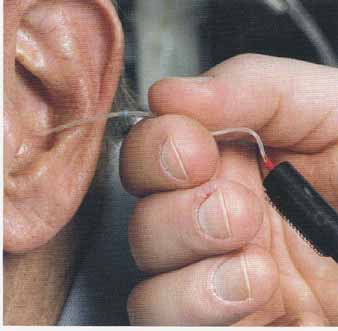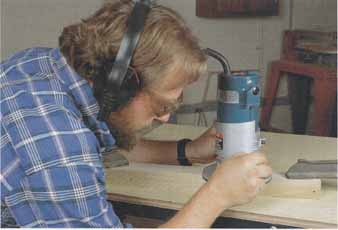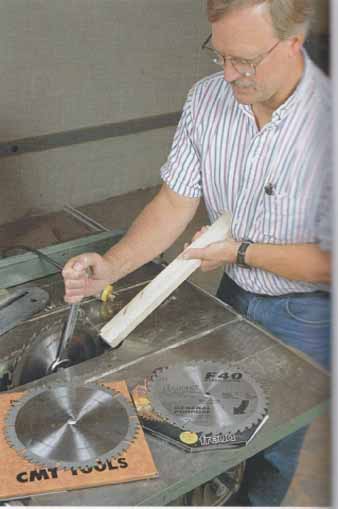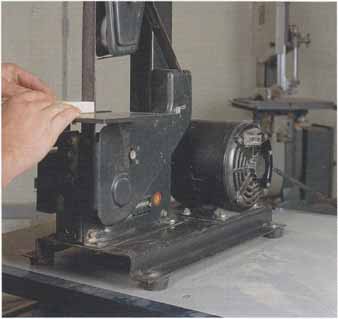Those tools that we most need to use are the very ones that offer the greatest potential danger to our ears. Common woodworking machines such as routers, planers, and table saws can cause permanent hearing damage. The good news is that there are easy ways to protect your hearing while continuing to work wood with power tools. But first it helps to understand the problem.
Hearing-Damage Basics
Loud sounds damage hearing in much the same way that earthquakes damage buildings. Loud sounds simply shake apart the delicate inner-ear structures called hair cells. These hair cells are highly specialized nerve endings designed to receive sound energy and convert it into neural impulses. In turn, those neural impulses produce our ability to hear. Sound waves strike all parts of our body, but only the hair cells of the inner ear can convert that sound energy into what causes us to hear. Once destroyed, the hair cells are gone forever.
Open a pea pod, and take out one pea. That is about the size of your inner ear, and amazingly, it contains 30,000 hair cells and approximately the same number of nerve fibers leading away from the hair cells up to the brain. You can easily appreciate that the inner ear is not only a very delicate structure, but it is compacted into a very small space.
Measuring Woodworking Noise
As might be imagined, damage to the ears produced by loud sounds is a combination of the intensity of the sound and the length of time to which one is exposed to that sound. Sound measurements of what we commonly call loudness, which actually measure the sound pressure level (SPL), are expressed in decibels (dB). Decibel units represent a logarithmic scale because the human ear can perceive such a large range of different intensities. Logarithmic notations are expressions of ratios; for ex ample, if one sound is twice as intense as another sound, it is 6 dB more intense. If one sound is 10 times more intense than a second sound, the first sound is 20 dB more intense.
The federal Occupational Safety and Health Administration (OSHA) standards limit industrial workers to 90 dB SPL for an 8-hour day. For sound levels of 95 dB, only a 4-hour work day is allowable. At a sound level of 100 dB, the allowable workday is 2 hours, for 105 dB, 1 hour, 110 dB, 30 minutes, 115 dB, 15 minutes and so on.

PROPER EAR PROTECTION HELPS PREVENT HEARING DAMAGE:
Common woodworking machines, like this table- mounted router, can quickly
damage hearing unless you protect your ears. Here, a foreman of the
carpenter shop at Oregon Health Sciences University, wears ear muffs
during tests conducted by the Oregon Hearing Research Center.

THE EAR IS AN AMPLIFIER: Using this miniature microphone
inserted into the ear canal, researchers measured sound levels right
at the ear drum. The findings showed the ear canal amplifies wood working
noise on average by about 7 dB over conventional readings taken at
ear level.
To study how woodworking machines affect hearing, members of the Oregon Hearing Research Center staff measured the intensity (loudness) of the sound in the conventional manner, at the ear level. But we also used special equipment—a miniature microphone—to measure sound intensity inside the ear canal at the eardrum itself (see the photo at left).The chart on the facing page lists our measurements of typical wood working machines under appropriate and normal operating conditions. Keep in mind, however, that tools vary from maker to maker, with some being louder than others.
The sound measured at the eardrum is significantly louder than that same sound measured at ear level. In practical terms, that means that the ear canal leading to the eardrum produces some amplification of the sound intensity For example, the noise generated by the 15-in, planer was 9 dB more intense at the eardrum than when measured at the ear level. On average, the sound produced by the machines we measured was increased by the ear canal about 2 dB (and remember an increase of 6 dB is doubling of the sound intensity). In other words, sounds are more than twice as loud at the eardrum.
Another problem with woodworking power tools is that when we hold them, we stimulate our ears by bone conduction (sound traveling through the body), as well as by airborne sounds. Ear muffs and ear plugs block out sound coming to the ear through the air. When bone conduction of sound is involved, it would be desirable to use the power tool in short bursts to minimize any accumulation effect. Anti-vibration gloves may also help, but we have not tested them.
Warning Signs of Hearing Damage
HOW LOUD ARE WOODWORKING MACHINES? |
||
Type of Machine |
Sound Intensity: at Ear level; at Eardrum |
|
Nail Gun (6d 2-in, finish nail) Chop saw Router 15-in, planer 10-in. table saw Palm sander (quarter sheet) Panel cutter Dust collector Band saw Shop vacuum 10-in. table saw (with Silencer blade) 6-in, jointer |
104dB 102dB 104dB 96dB 95dB 96dB 95dB 93dB 92dB 90dB 86dB 80dB |
110dB 108dB 107dB 105 dB 103dB 103 dB 102 dB 99dB 98dB 97dB 93dB 90dB |
When other parts of our bodies are dam aged, the warning signal is pain. But for the ear, the warning signal is tinnitus (ringing in the ears). Ringing in the ears after exposure to a woodworking tool means that tool was too loud for your ears and that you should always wear ear protection in the future when using that tool. Don’t be guided by the actions of others. Some people have tough ears, and some people have tender ears, with all grades in between. You may have noted that Norm Abram of The New Yankee Workshop seldom wears ear protection. I would assume that Mr. Abram has tough ears.
The way in which hearing impairment starts can be deceptive, so deceptive as to go unnoticed initially Imagine the inner ear laid out like a piano keyboard, the low frequencies to the left and the high frequencies to the right, with each frequency systematically spaced in between. It is the high frequencies that are damaged initially by loud sounds, so one can sustain a considerable amount of damage before the ability to hear the lower pitches becomes impaired. The sounds to which we pay attention and which we commonly use are restricted to the low-frequency portion of the ear, starting with about 4,000 Hz (cycles per second) and moving to lower pitches.
The typical course of hearing loss is something like this: With the initial hearing loss, the person has no difficulty hearing and understanding speech as long as the person is in a relatively quiet place. But when there is background noise pres ent (in a restaurant or at a cocktail party, for example), the person will hear speech, but he or she will not be able to understand it. This condition is an early warning of hear ing loss. Moreover, that kind of hearing loss often can be compensated by a pair of properly fitted hearing aids.
Ear Protection

Harmful sound also can be transmitted through your
hands. Proper ear protection may not be enough when using handheld
power tools like this router. Bone conduction can transmit harmful
noise through your body to your ears. Limiting the duration of use
of such tools may help.

TAKE OFF THOSE NOISY SAWBLADES AND REPLACE THEM. Several
manufacturers, including Freud, CMT, and Everlast (not shown) now offer
special saw blades designed to cut down on noise. Changing to one of
these blades may reduce saw noise by up to 7dB. The blades have laser
cuts that dampen noise and vibration.
There are two common forms of ear protection: ear muffs and ear plugs. In extreme cases, it is advisable to use both types at the same time. Much has been made of ear plugs as a protective device, and it is true that ear plugs work about as well as ear muffs. Ear plugs such as the foam EAR brand plugs available in most drugstores, are good protective devices, and they are inexpensive. A disadvantage of ear plugs is that they can be difficult to insert correctly. And it takes time to get them inserted. In addition, the ear plug is vulnerable to jaw movements, which can break the sound seal. Place your finger in your ear and move the jaw, as in chewing or talking, and note the amount of ear canal movement. It is this movement that can make ear plugs less effective.
Properly selected ear muffs offer as much sound protection as do custom- fitted ear plugs. More important, ear muffs are easier to put on and take off, provided they are available at each noisy machine. If the muffs are on the other side of the shop from the tool being used, there’s an inclination to say, “This is a very brief task; I don’t really need ear protection. “We recommend that a pair of ear muffs be placed on each machine capable of producing ear-damaging loud sounds. The ear bows of safety glasses can break the sound seal for some ear muffs. but our research showed the cuffs on the Thunder 29 ear muffs available from Safety and Supply (see Sources) are sufficiently pliable that they can be worn over glasses without any loss of sound protection.
Quieting Woodworking Machines
In addition to ear protection, it is possible to reduce the amount of sound generated by certain machines. Several manufacturers are marketing so-called quiet saw blades (see the right photo on the facing page).We tried the Silencer 10-in., saw blade available from Everlast Saw and Carbide Tools, Inc. (see Sources), and we found it reduced table— saw noise level by 9 dB when compared to a regular carbide blade. Remember that reducing sound intensity by 6 dB means cutting the intensity in half a reduction of 10 dB means a reduction of three times. Thus the 9-dB sound reduction provided by the Silencer blade is significant.
Many machines, such as the band- saw; produce some of their noise by the resonance of their metal panels. Attaching pieces of plywood to these panels helps reduce the sound generated by the saw. For example, the noise produced by a 16-in. Grizzly band saw was reduced from 92 dB to 89 dB by loading its panels with plywood. Mounting tools on rubber isolation blocks or wood mounts can reduce sound levels (see the photo at right).
Keep tools in good working order. Dull tools tend to make more noise than do sharp ones. Misaligned belts and pulleys can generate excess drive—train noise. Worn or poorly lubricated bearings will add to noise.
Think about your hearing when you purchase woodworking equipment. Some designs and individual tools are louder than others. Machines with universal motors tend to be louder than those with induction motors. Gear-driven tools are usually louder than belt—driven or direct—drive tools.
In general, shielding, insulating and muffling can reduce machine noise. The degree to which these procedures are effective depends in part upon the conditions of the individual shop, such as size, shape, surface of the walls, ceiling construction, and ceiling height. Each situation requires individual attention. But the point is to look for ways to reduce sound levels, and you will find them.
It’s important to prevent permanent damage by protecting your ears from harmful noise any way you can. Remember: If after exposure to a noise your ears ring, even briefly, then the sound was too intense for your ears, and in the future, use ear protection.

RUBBER MOUNTING PADS CAN CUT MACHINE NOISE, Mounting
machines on anti- vibration mats or on rubber foot pads, such as those
on this 1-in, belt sander, can cut down on woodworking noise by isolating
or dissipating the vibration that causes noise.